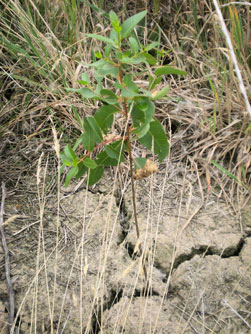





Back to Factsheets | Download PDF | Every now and then I get woken out of my stupor and actually start to use the old grey matter. Some of you may find that hard to believe but it's true. I was planting trees at a property near Bambra this past September. You remember September don't you? Let me remind you that it is a month in spring, it rains a lot, blows a gale, temperatures in the mid-high teens if you're lucky - generally perfect for planting trees in our region. Somehow September got waylaid this year. It decided it wanted to be a summer month. No rain, plenty of warmth and unfortunately for us tree planters, not much in the way of soil moisture. I was lured out of my sleep walking when I started pogo-ing (for the uninitiated that means removing a plug of soil out of the ground with a hamilton tree planter) ground that was hard as a rock. The area that I was planting was newly fenced from an existing paddock and part of the area to be treed had been cut for hay last December. What woke me up was that the soil was much harder and drier in the area that had been cut for hay. Only 3 metres away in the uncut area the ground was soft and the ease to which I could pogo was amazing. I was on a roll then. I'd forgotten all about the musical merits of the handsaw and became quite interested in the subject of successfully growing trees in very dry years. The following is a list of ideas I came up with that may help other tree planters maintain soil moisture for extended periods on tree planting sites in dry conditions. 1) The area that was cut for hay had a grass length of approximately 15cm(6") thus the direct sun was able to dry the soil out faster than the uncut area. 2) The uncut area was overgrown with dead grass that had become rank by late summer thus insulating the ground from the sun's direct rays and holding the moisture in the topsoil. 3) The spots were sprayed twice prior to planting. The first time in May with Roundup and the second was the recommended dose of Roundup and Simazine three weeks before planting. In a year of average rainfall (or greater) spraying twice prior to planting is certainly important for decreasing the weed seeds in the topsoil but in a year of below average rainfall (like this year) those two sprays have helped to conserve what little soil moisture is available for the tree seedling's use. And don't forget that the weeds form a mulch when sprayed with a knockdown herbicide like Roundup helping with that insulating factor mentioned in no. 2 above. 4) On another job the gully to be planted with trees had previously been infested with bracken , blackberry, ox-eye daisy, and ragwort. The landowner had spent a lot of time getting these under control with chemicals and fire and thus only one spray (Roundup and Simazine) three weeks prior to tree planting was necessary. 5) I've noticed some landowners who have prepared sites in advance with pre- emergent herbicides(ie., Simazine, etc.) put stock into the plantation site prior to planting to eat the grass down between the sprayed rows. From a fire prevention perspective this may be important. However, from a weed control perspective within the sprayed area ( and thus from a soil moisture perspective) the effectiveness of the Simazine may diminish. Simazine affects the plants' photosynthetic ability and it does this by attacking the roots first. When weed seeds germinate, the Simazine (which remains in the soil for weeks/months) enters the growing root and kills the weed seedling before it emerges from the soil. When stock (or humans or vehicles) walk on the sprayed soil, the layer of Simazine in the soil is disturbed. Quick growing "summer weeds" may germinate and outcompete the tree seedling for the valuable soil moisture. Well, that might do me for now. My head is aching after all the activity its just been put through plus my daughter has just put Locomotion on by Kylie Minogue and , well, umm, er.... |

